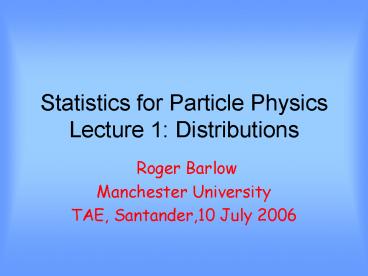Statistics for Particle Physics Lecture 1: Distributions - PowerPoint PPT Presentation
1 / 16
Title:
Statistics for Particle Physics Lecture 1: Distributions
Description:
TAE, Santander,10 July 2006. Roger ... Statistics is not Physics. It is not fundamental. ... Radioactive decays' Geiger counter clicks are classic example ... – PowerPoint PPT presentation
Number of Views:69
Avg rating:3.0/5.0
Title: Statistics for Particle Physics Lecture 1: Distributions
1
Statistics for Particle PhysicsLecture 1
Distributions
- Roger Barlow
- Manchester University
- TAE, Santander,10 July 2006
2
Statistics Why?
- Statistics is not Physics. It is not
fundamental. - But it is essential in our understanding of the
experimental results which do led us towards the
fundamental truths. - We learn this the hard way, as individuals and as
a community
3
Two sorts of Statistics
- Descriptive Statistics
- How to convey information from complex data to
audience (public, colleagues, superiors) - Simple numbers and plots
- Driven by convention and common sense
- Used by businessmen, journalists, and almost
everybody - An Art
- Inferential Statistics
- What the data is trying to tell us about the
process that produced it - Algorithms may be simple or complicated
- Rigorous and verifiable
- Used by Physicists, doctors, and farmers
- A Science
4
Topic Distributions
- Any non-deterministic model involves random
distributions. (Discrete or continuous) - Lots of these Uniform, exponential, Chi-squared,
- 3 most important
- Binomial
- Poisson
- Gaussian
r
x
5
Binomial P(rn,p)
- Tossing n coins. Probability of r heads and n-r
tails is - P(rp,n)__n!__ pr(1-p) n-r
- r! (n-r)!
- Mean is ?np. Width described by ??np(1-p)
- 1-p is often written q. Makes the formulae more
elegant
5 trials
50 probability
90 probability
10 probability
6
When do we meet it?
- Numbers of hits in Tracking chambers
- Track-finding and Particle ID event efficiencies
and multiplicities - Monte Carlo event generation (but see later)
- Honestly, not very often
7
Poisson
- Probability of r events when the mean is ? is
P(r?)e- ? ? r - r!
- Mean is ?. Standard deviation is ??.
- Works for large and small ?
Mean 5.4
Mean 0.2
8
When do we get a Poisson distribution?
- Discrete events in a continuum
- Radioactive decays Geiger counter clicks are
classic example - Numbers of events in data in particular numbers
of rare events found. And numbers of events in
histogram bins
9
The Gaussian
1 . ??2?
- P(x?,?) exp (-(x- ?)2/ 2?2)
There is only one universal Gaussian picture.
Everything else is scaling and translation.
Peaks at x ? Width described by ? Bell-shaped
curve
10
When do we get Gaussians
- Lots! Everything becomes Gaussian in some large
n limit thanks to the Central Limit Theorem (CLT) - If y is a random variable made by the
convolution of n random variables xi, then - my?mxi
- ?2y??2xi
- The distribution function for y becomes Gaussian
for large n
11
The Standard Deviation
- Any distribution has a mean ??x P(x) dx and a
standard deviation given by - ?2?(x-?)2 P(x) dx
- Standard deviations add in quadrature (apart from
complications due to correlations.) - For the Gaussian only, 68 of P(x) lies with ? ?,
95 within ? 2 ?, 99.7 within ? 3 ?
Apart from some pathological exceptions you
should pray you never meet
12
Convolutions that help us
- Poisson Poisson Poisson
- Separate sources add and can be treated as a
single source - Poisson Binomial Poisson
- A poisson source modified by a binomial detection
efficiency gives a poisson number of detected
events
13
Limit Binomial ? Poisson
- Fixing n?p as n increases binomial becomes
Poisson - So we can use Poisson for MC data, which is truly
binomial (unlike real data, which is Poisson)
Poisson(r,0.2)
14
Limit Binomial ? Gaussian
All with p0.2
N10
N20
N80
N40
15
Limit Poisson ? Gaussian
16
Now try and example
- Gaussian uniform































